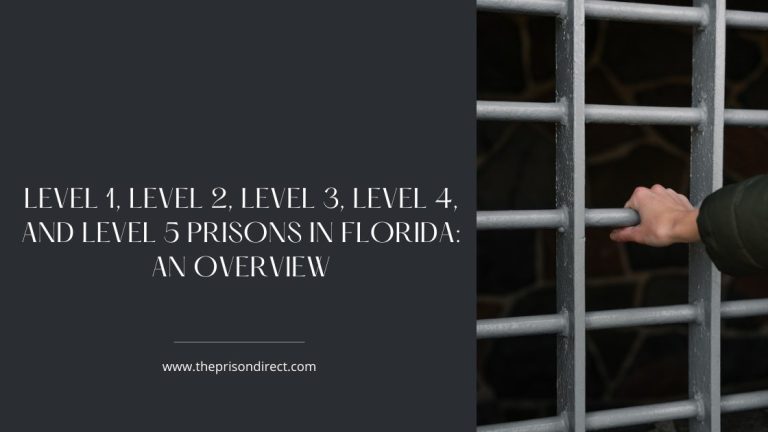Minimum, Medium, and Maximum Security Level Prisons in Illinois
Introduction to the Criminal Justice System in Illinois
The criminal justice system in Illinois is responsible for maintaining law and order, protecting the rights of citizens, and ensuring that those who violate the law are held accountable. The purpose of this article is to provide a comprehensive overview of the different security levels in Illinois’ prison system and the impact of these security levels on inmates, rehabilitation and reentry programs, and the prison system as a whole.
A brief history of the criminal justice system in Illinois is that it has evolved over time to meet the changing needs of society. The first prisons in Illinois were established in the early 1800s and were designed to hold convicted criminals. Since then, the prison system has grown and expanded to include a range of facilities, including minimum, medium, and maximum security level prisons.
Minimum Security Level Prisons in Illinois
Minimum security level prisons in Illinois are designed to house low-risk inmates who have been convicted of non-violent crimes. These facilities are characterized by a relaxed atmosphere and few security measures, such as perimeter fencing and armed guards. Inmate populations in minimum security level prisons are typically made up of those who are close to being released and those who have been sentenced to short-term stays.
Benefits of minimum security level prisons for inmates include access to a range of educational and vocational programs, as well as opportunities for work and community service. These programs are designed to help inmates prepare for reentry into society and reduce the likelihood of recidivism.
Medium Security Level Prisons in Illinois
Medium security level prisons in Illinois are designed to house inmates who pose a moderate risk to public safety. These facilities have more security measures in place, such as multiple perimeter fences and armed guards, compared to minimum security level prisons. Inmate populations in medium security level prisons include those who have been convicted of more serious crimes and those who have a history of violent behavior.
Benefits of medium security level prisons for inmates include access to a wider range of educational and vocational programs, as well as opportunities for work and community service. Inmates in medium security level prisons also have access to medical and mental health services, which can help them address any underlying issues that may have contributed to their criminal behavior.
Maximum Security Level Prisons in Illinois
Maximum security level prisons in Illinois are designed to house the most dangerous and high-risk inmates. These facilities have the highest level of security measures, including multiple perimeter fences, armed guards, and surveillance cameras. Inmate populations in maximum security level prisons include those who have been convicted of violent crimes and those who pose a significant threat to public safety.
Benefits of maximum security level prisons for inmates are limited, but they do have access to medical and mental health services. Inmates in maximum security level prisons are also typically placed in restrictive housing units, which can help to reduce the risk of violence and promote safety for both inmates and staff.
Comparison of Minimum, Medium, and Maximum Security Level Prisons in Illinois
When comparing minimum, medium, and maximum security level prisons in Illinois, it is important to consider the security measures in place, the facilities and services available, and the inmate populations.
In terms of security measures, minimum security level prisons have the fewest security measures, while maximum security level prisons have the most. Medium security level prisons fall somewhere in between.
Facilities and services also vary between minimum, medium, and maximum security level prisons. Minimum security level prisons typically have the most extensive range of programs and services, while maximum security level prisons have the fewest. Medium security level prisons fall somewhere in between.
Inmate populations also differ between minimum, medium, and maximum security level prisons. Minimum security level prisons have the lowest risk inmate population, while maximum security level prisons have the highest risk inmate population. Medium security level prisons have a moderate risk inmate population.
Impact of Security Level on Rehabilitation and Reentry Programs
Rehabilitation and reentry programs are designed to help inmates prepare for life outside of prison and reduce the likelihood of recidivism. The impact of security level on rehabilitation and reentry programs is significant, as access to these programs varies between minimum, medium, and maximum security level prisons.
In minimum security level prisons, inmates have the most extensive access to rehabilitation and reentry programs, including education and vocational programs, work opportunities, and community service. In medium security level prisons, access to rehabilitation and reentry programs is somewhat more limited, but still available. In maximum security level prisons, access to rehabilitation and reentry programs is the most limited, with a focus on providing medical and mental health services.
Challenges Facing the Illinois Prison System
Despite the many benefits of the criminal justice system in Illinois, there are several challenges that the prison system faces. These challenges include overcrowding, budget constraints, staff shortages, and concerns about inmate health and safety.
Overcrowding is a major issue in the Illinois prison system, with many facilities operating at or above capacity. This can lead to overcrowded conditions, which can impact the health and safety of both inmates and staff.
Budget constraints are another challenge facing the Illinois prison system, with limited resources available to provide essential services, such as medical and mental health services.
Staff shortages are also a concern, as the number of staff members in the Illinois prison system is not sufficient to meet the growing demands of the system. This can result in a lack of adequate supervision and support for inmates, which can negatively impact their rehabilitation and reentry into society.
Inmate health and safety is also a concern in the Illinois prison system, with reports of violence and abuse being reported. This highlights the need for adequate staffing levels, as well as effective rehabilitation and reentry programs, to ensure the well-being of inmates and promote public safety.
Conclusion
The criminal justice system in Illinois plays a crucial role in maintaining law and order, protecting the rights of citizens, and ensuring that those who violate the law are held accountable. The different security levels in the Illinois prison system, including minimum, medium, and maximum security level prisons, have a significant impact on inmates, rehabilitation and reentry programs, and the prison system as a whole.
It is important to consider the security measures in place, the facilities and services available, and the inmate populations when comparing minimum, medium, and maximum security level prisons in Illinois. Rehabilitation and reentry programs play a key role in helping inmates prepare for life outside of prison and reducing the likelihood of recidivism, but access to these programs varies depending on the security level of the prison.
Despite the many benefits of the criminal justice system in Illinois, the prison system faces several challenges, including overcrowding, budget constraints, staff shortages, and concerns about inmate health and safety. Addressing these challenges is essential to ensure the well-being of inmates and promote public safety.
Frequently Asked Questions (FAQs)
Q1: What is the purpose of the criminal justice system in Illinois? The purpose of the criminal justice system in Illinois is to maintain law and order, protect the rights of citizens, and ensure that those who violate the law are held accountable.
Q2: What is the difference between minimum, medium, and maximum security level prisons in Illinois? Minimum security level prisons in Illinois are designed to house low-risk inmates, medium security level prisons are designed to house moderate risk inmates, and maximum security level prisons are designed to house high-risk inmates. The level of security measures in place, facilities and services available, and inmate populations vary between these different security levels.
Q3: What is the inmate population in minimum security level prisons in Illinois? The inmate population in minimum security level prisons in Illinois is typically made up of low-risk inmates who have been convicted of non-violent crimes and are close to being released or have been sentenced to short-term stays.
Q4: What is the impact of security level on rehabilitation and reentry programs in Illinois? The impact of security level on rehabilitation and reentry programs in Illinois is significant, as access to these programs varies between minimum, medium, and maximum security level prisons. In minimum security level prisons, inmates have the most extensive access to rehabilitation and reentry programs, while in maximum security level prisons, access to these programs is the most limited.
Q5: What are the challenges facing the Illinois prison system? The challenges facing the Illinois prison system include overcrowding, budget constraints, staff shortages, and concerns about inmate health and safety. Addressing these challenges is essential to ensure the well-being of inmates and promote public safety.








